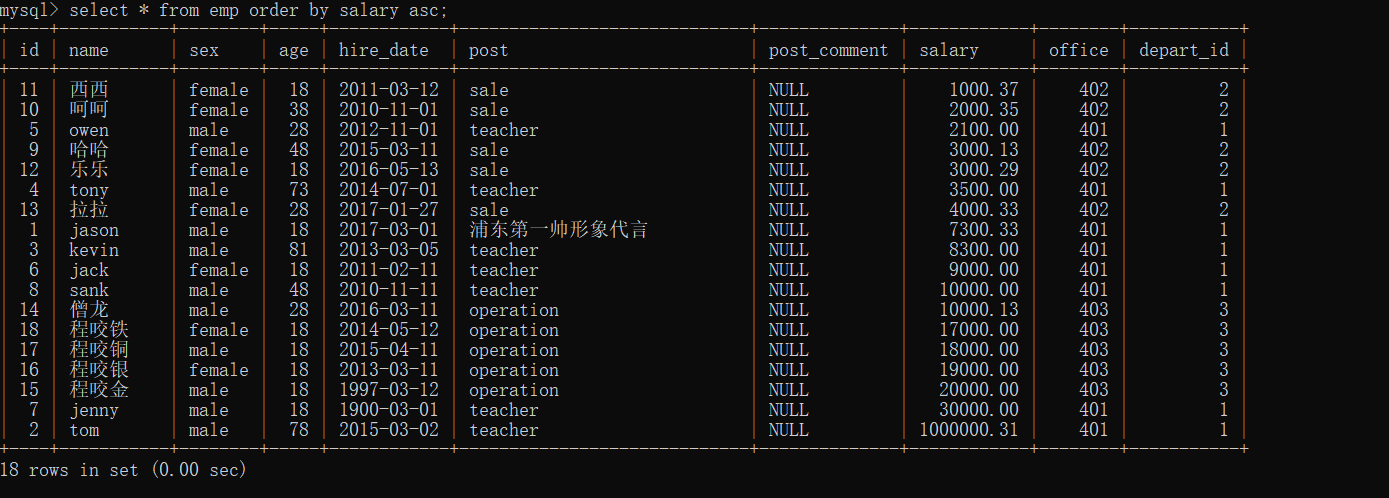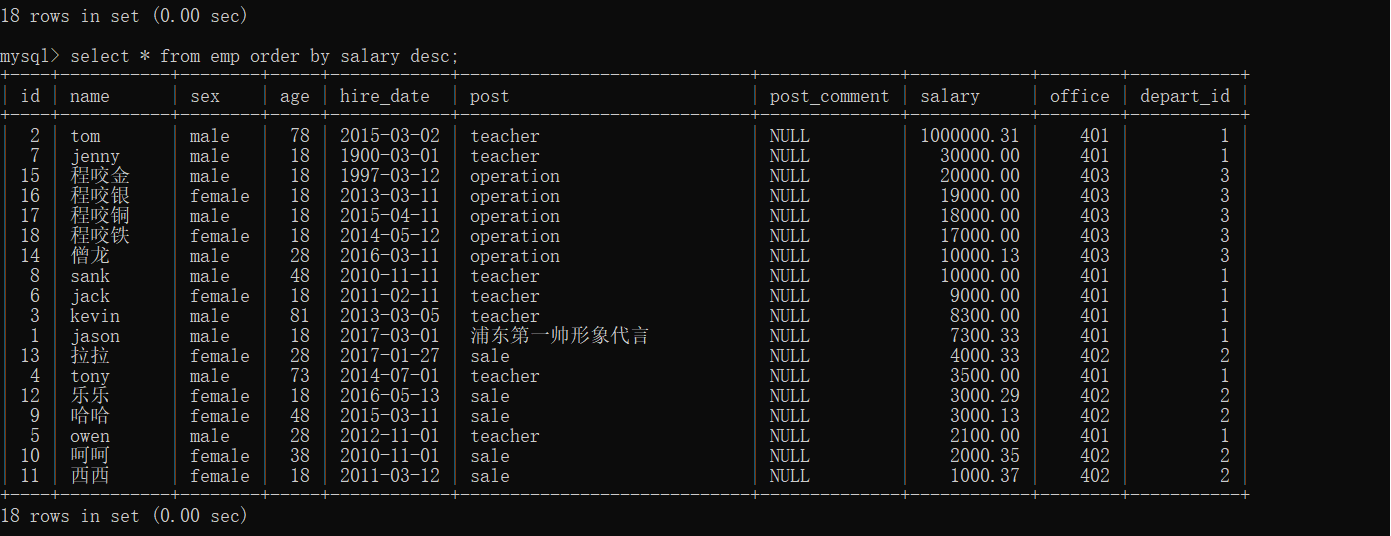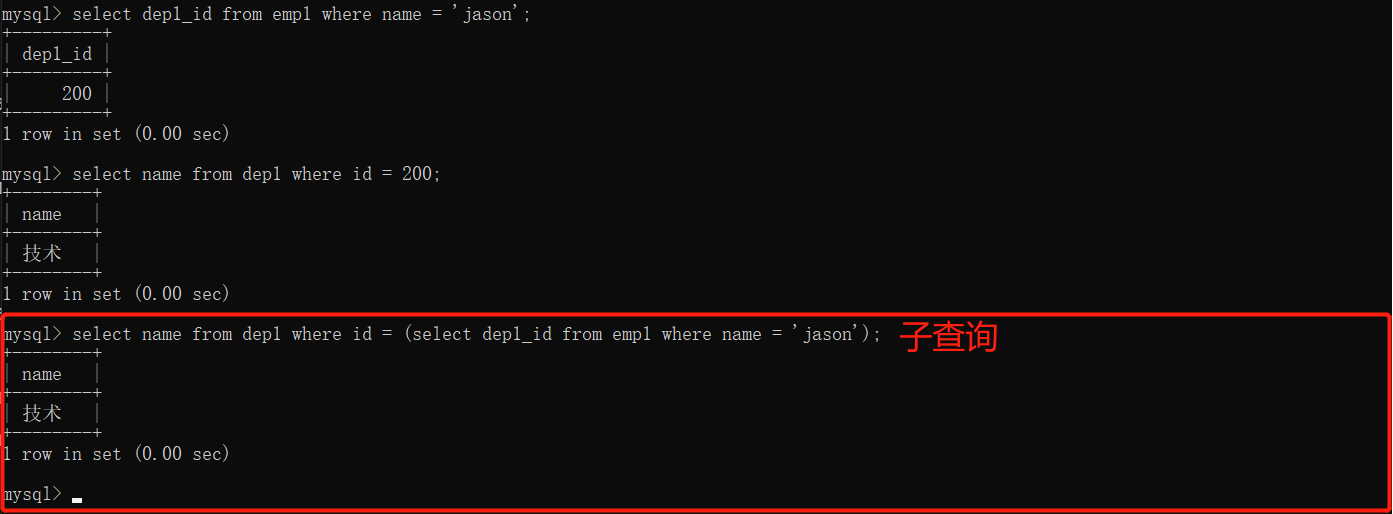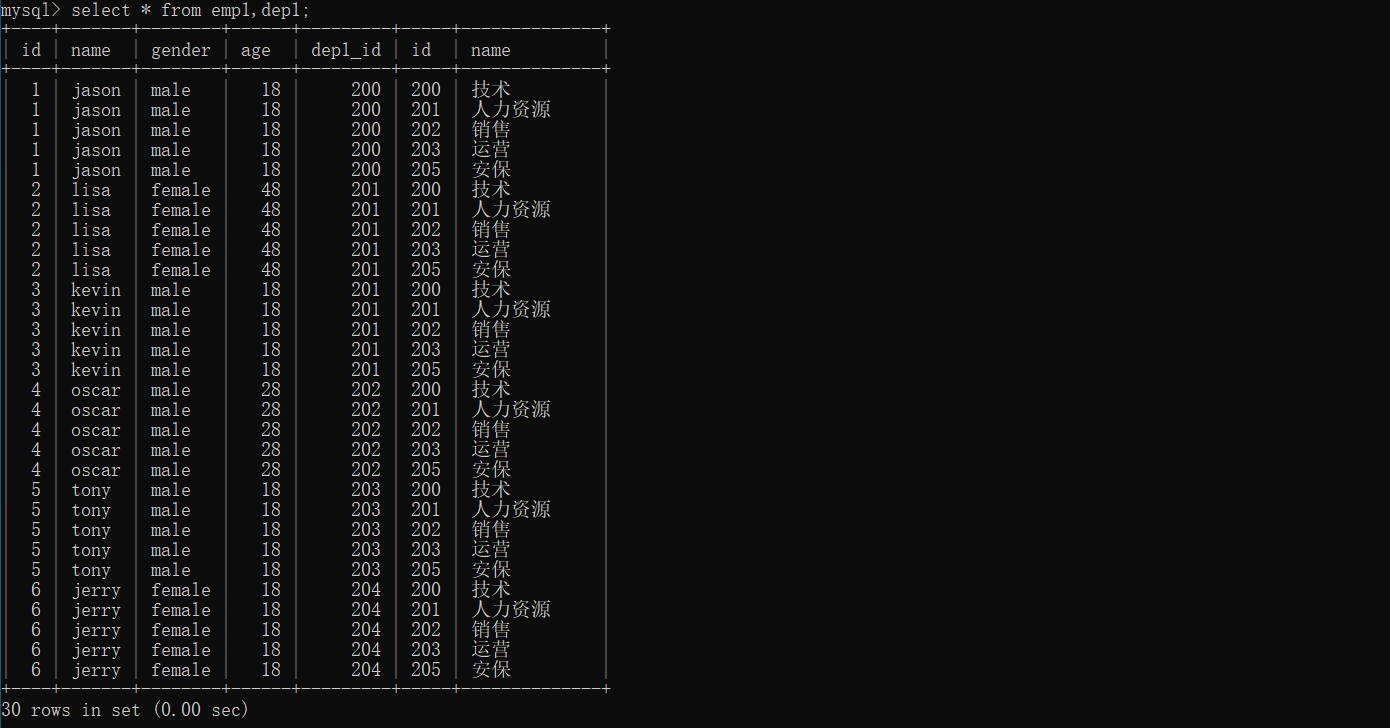今日内容
操作表的SQL语句补充
1.修改表名
alter table 表名 remane 新表名;
2.新增字段
alter table 表名 add 字段名 字段类型(数字) 约束条件;
alter table 表名 add 字段名 字段类型(数字) 约束条件 after 已经存在的字段;
alter table 表名 add 字段名 字段类型(数字) 约束条件 first;
3.修改字段
alter table 表名 change 旧字段 新字段 字段类型(数字) 约束条件;
alter table 表名 modify 字段名 新的字段类型(数字) 约束条件;
4.删除字段
alter table 表名 drop 字段名;
查询表关键字
1.数据准备(直接拷贝)
create table emp(
id int not null unique auto_increment,
name varchar(20) not null,
gender enum('male','female') not null default 'male', #大部分是男的
age int(3) unsigned not null default 28,
hire_date date not null,
post varchar(50),
post_comment varchar(100),
salary double(15,2),
office int, #一个部门一个屋子
depart_id int
);
#三个部门:教学,销售,运营
insert into emp(name,gender,age,hire_date,post,salary,office,depart_id) values
('jason','male',18,'20170301','浦东第一帅形象代言',7300.33,401,1), #以下是教学部
('tom','male',78,'20150302','teacher',1000000.31,401,1),
('kevin','male',81,'20130305','teacher',8300,401,1),
('tony','male',73,'20140701','teacher',3500,401,1),
('owen','male',28,'20121101','teacher',2100,401,1),
('jack','female',18,'20110211','teacher',9000,401,1),
('jenny','male',18,'19000301','teacher',30000,401,1),
('sank','male',48,'20101111','teacher',10000,401,1),
('哈哈','female',48,'20150311','sale',3000.13,402,2),#以下是销售部门
('呵呵','female',38,'20101101','sale',2000.35,402,2),
('西西','female',18,'20110312','sale',1000.37,402,2),
('乐乐','female',18,'20160513','sale',3000.29,402,2),
('拉拉','female',28,'20170127','sale',4000.33,402,2),
('僧龙','male',28,'20160311','operation',10000.13,403,3), #以下是运营部门
('程咬金','male',18,'19970312','operation',20000,403,3),
('程咬银','female',18,'20130311','operation',19000,403,3),
('程咬铜','male',18,'20150411','operation',18000,403,3),
('程咬铁','female',18,'20140512','operation',17000,403,3);
表数据

查询关键字之select与from
'''
SQL语句的关键字编写顺序与执行顺序是不一致的!!!
eg: select name from emp;
肯定是先支持from确定表 之后执行select确定字段
编写SQL语句针对select和from可以先写个固定模板
select * from 表名 其他操作
select后的字段可能是实际的 也可能是通过SQL动态产生的 所以可以先用*占位最后再修改
'''
1.select
自定义查询表中字段对应的说话
2.from
指定操作的对象(到底来自哪张表 有可能是多张表)
查询关键字之where筛选
刚开始接触mysql查询的时候 建议按照查询的优先级顺序拼写出你的sql语句
1.先是查哪张表 from emp
2.再是根据什么条件去查 where id = 6
3.再是对查询出来的数据筛选展示部分 select name,salary
1.查询id大于等于3小于等于6的数据(两种方式)
select id,name from emp where id >= 3 and id <= 6;
select id,name from emp where id between 3 and 6;

2.查询薪资是20000或者18000或者17000的数据(两种方式)
select * from emp where salary = 20000 or salary = 18000 or salary = 17000;
select * from emp where salary in (20000,18000,17000);

3.查询员工姓名中包含o字母的员工姓名和薪资
select name,salary from emp where name like '%o%';

4.查询员工姓名是由四个字符组成的员工姓名与其薪资(两种方式)
select name,salary from emp where name like '____';
select name,salary from emp where char_length(name) = 4;

5.查询id小于3或者大于6的数据
select * from emp where id not between 3 and 6;

6.查询薪资不在20000,18000,17000范围的数据
select * from emp where salary not in (20000,18000,17000);

7.查询岗位描述为空的员工名与岗位名 针对null不能用等号,只能用is
select name,post from emp where post_comment = NULL; # 查询为空
select name,post from emp where post_comment is NULL;
select name,post from emp where post_comment is not NULL;

查询关键字之group by分组
分组:按照一些指定的条件将单个单个的数据分为一个个整体
分组之后我们研究的对象应该是以组为单位 不应该再直接获取单个数据项 如果获取了应该直接报错 select后面可以直接填写的字段名只能是分组的依据(其他字段需要借助于一些方法才可以获取)
set global sql_mode='strict_trans_tables,only_full_group_by';
我们写SQL是否需要使用分组 可以在题目中得到答案
每个、平均、最大、最小
配置分组常见使用的有聚合函数
| 序号 | 关键字 | 作用 |
|---|---|---|
| 1. | max | 最大值 |
| 2. | min | 最小值 |
| 3. | sum | 总和 |
| 4. | counnt | 计数 |
| 5. | avg | 平均值 |
1.每个部门的最高薪资
select post,max(salary) from emp group by post;

2.每个部门的最低薪资
select post,min(salary) from emp group by post;

3.每个部门的平均薪资
select post,avg(salary) from emp group by post;

4.每个部门的工资总和
select post,sum(salary) from emp group by post;

5.每个部门的人数
select post,count(salary) from emp group by post;

6.在显示的时候还可以给字段取别名
as也可以省略 但是不推荐省 因为寓意不明确
mysql> select post as '部门',max(salary) as '最高薪资' from emp group by post;
mysql> select post '部门',max(salary) '最高薪资' from emp group by post;

group_conca(分组之后用)不仅可以用来显示除分组外字段还有拼接字符串的作用
1.每个人的名字
mysql> select post,group_concat(name) from emp group by post;

2.添加后缀
mysql> select post,group_concat(name,'_NB') from emp group by post;

3.拼接字符串
select post,group_concat(name,'薪资为: ',salary) from emp group by post;

4.每个人的薪资
mysql> select post,group_concat(salary) from emp group by post;

查询关键字之having过滤
where与having的功能其实是一样的 都是用来筛选数据
只不过where用于分组之前的筛选 而having用于分组之后的筛选
为了人为的区分 所以叫where是筛选 having是过滤
1.统计各部门年龄在30岁以上的员工平均工资,并且保留平均工资大于10000的部门
select post,avg(salary) from emp where age > 30 group by post having avg(salary) > 10000;

查询关键字之distinct去重
去重的前提是数据必须是一模一样
select distinct age from emp;

查询关键字之order by排序
1.升序(默认的)
select * from emp order by salary asc;

2.降序
select * from emp order by salary desc;

案例:统计各部门年龄在10岁以上的员工平均工资,并且保留平均工资大于1000的部门,然后对平均工资进行排序
select post,avg(salary) from emp where age > 10 group by post having avg(salary) > 1000 order by avg(salary);

查询关键字之limit分页
1.限制展示条数
select * from emp limit 3;

2.分页展示
第一个参数表示起始位置,第二个参数表示的是条数,不是索引位置
select * from emp limit 5,5;

查询关键字之regexp正则
select * from emp where name regexp'^j.*(n\y)$';

多表查询思路
1.子查询
将一张表查询结果用括号括起来当做另外一条SQL语句的条件
eg:
第一步干什么
第二步基于第一步的结果在做操作
2.连表查询
现将所有涉及到结果的表全部拼接到一起形成一张大表 然后从大表中查询数据
# 建表
create table dep1(
id int primary key auto_increment,
name varchar(20)
);
create table emp1(
id int primary key auto_increment,
name varchar(20),
gender enum('male','female') not null default 'male',
age int,
dep1_id int
);
# 插入数据
insert into dep1 values
(200,'技术'),
(201,'人力资源'),
(202,'销售'),
(203,'运营'),
(205,'安保')
;
insert into emp1(name,gender,age,dep1_id) values
('jason','male',18,200),
('lisa','female',48,201),
('kevin','male',18,201),
('oscar','male',28,202),
('tony','male',18,203),
('jerry','female',18,204);
子查询
查询jason的部门名称
1.先获取jason的部门编号
select dep1_id from emp1 where name = 'jason'; # 200
2.根据部门编号获取部门名称
select name from dep1 where id = 200;
3.子查询
select name from dep1 where id = (select dep1_id from emp1 where name = 'jason');

连表操作
1.笛卡尔积
select * from emp1,dep1;
'
我们不会使用笛卡尔积来求数据 效率太低 连表有专门的语法
'

1.inner join内连接
作用:只能拼接两边都有的字段
select * from emp1 inner join dep1 on emp1.dep1_id = dep1.id;

2.left join左连接
作用:以左表为基准 展示所有的数据 没有对应数据则用NULL填充
select * from emp1 left join dep1 on emp1.dep1_id = dep1.id;

3.right join 右连接
作用:以右变为基准 展示所有的数据 没有对应数据则用NULL填充
select * from emp1 right join dep1 on emp1.dep1_id = dep1.id;

4.union 全连接
作用:左连接加右连接 左右两边的数据都有 没有数据的部分用NULL填充
select * from emp1 left join dep1 on emp1.dep1_id = dep1.id
union
select *from emp1 right join dep1 on emp1.dep1_id = dep1.id;



 posted on
posted on

